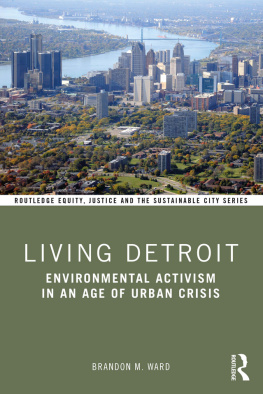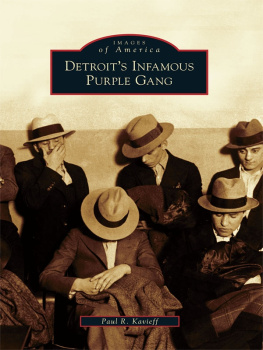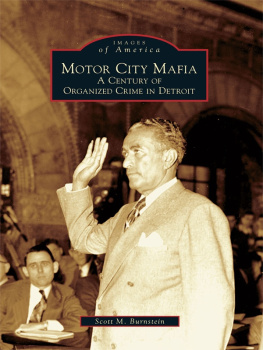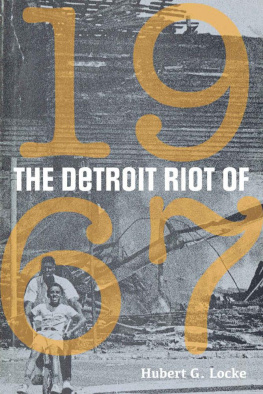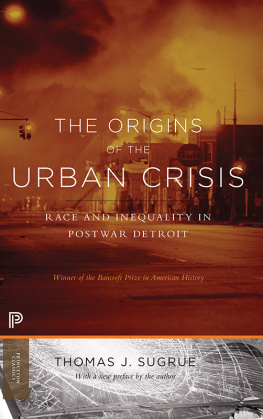Prologue to the 2017 Printing
Back in 2001, in the first printing of this book, I argued most forcefully that if one wanted really to comprehend the fate of Americas inner cities over the course of the postwar period, one had to begin by fully understanding what had happened in the Motor City. Detroit, I had maintained, was in fact ground zero for any scholar seeking to make sense of why cities across the nation that had seemed to be synonymous with economic opportunity and prosperity in the 1950s became, by the 1960s, the epicenter of countless rebellions for greater racial equality and, then, by the 1980s, bastions of crime and decay.
Today, on the occasion of the fiftieth anniversary of the historic urban rebellion that rocked the Motor City in July 1967, I realize that I had actually underestimated just how much the city of Detroit is a bellwether for urban America writ large. I had not fully appreciated just how important it is for the nation to pay attention to what happened, and continues to happen, in Detroit, Michigan, if it has any hope of making Americas inner cities prosperous and just for all who live in them.
* * *
July 23, 2017, marks the semicentennial of the infamous night when Detroit, Michigan, found itself engulfed in a fiery five-day protest that would end with forty-three people dead, 696 others wounded, and with the citys poorest neighborhoods smashed and smoldering. This event, known by too many as the Detroit Riot of 1967, was, in fact, an act of both rage and rebellion. It was the product of African Americans having suffered decades of brutality at the hands of the Detroit Police Department while civic leaderseven liberal leaders publicly committed to racial equalitywere not stopping the abuse. It was the result of the grinding poverty that continued to exist in Detroits black neighborhoods as white Detroiters enjoyed unprecedented prosperity. It happened because access to everything from good housing stock to strong schools remained elusive for black Detroiters while, for white city residents, such access was a given.
To be sure, Detroit was not the first inner city in which such a devastating history of law enforcement abuse and entrenched inequalities led to civic disorder. But while urban rebellions had erupted in places such as Philadelphia, Harlem, Rochester, Watts, and Newark well before one rocked the Motor City, Detroits urban insurrection was a particular shock to the nation. In short, not only had Detroit been, according to Franklin Delano Roosevelt, Americas Arsenal of Democracy, but it had also been heralded as an exciting and shining model of a 20th century city in the Great Society, according to powerful labor leaders like Walter Reuther. Indeed, state politicians from Los Angeles and New York City to federal legislators in Washington, D.C., had hoped that everything from President Lyndon Johnsons new social programs, which were rolled out with particular fanfare in the Motor City, to legislative victories such as the Civil Rights Act of 1965, which Detroit leaders had supported with particular zeal, would bring enough positive change to stem the tide of civil rights activism that was now washing over the North with as much force as it had the South. And yet, white politicians had underestimated the extent to which discrimination continued to plague the lives of African Americans in cities across the nation. Detroit was their wake-up call.
Still, when the fires of Detroits 1967 rebellion finally were extinguished, Americas power brokers and policymakers chose not to listen to those who had taken to the streets who spoke loudly about the desperation and frustration that had led to such a dramatic uprising. They simply refused to hear when those who rebelled spoke clearly and eloquently about being bone tired of police officer abuses, too few job opportunities, poorly run schools, and having to pay white business owners exorbitant prices for their basic necessities.
Politicians and policymakers didnt even listen to the experts whom they themselves had asked to determine why cities across the nation were erupting. Like those speaking out from the streets, those who had been appointed to local civil rights committees by mayors such as Jerome Cavanagh or governors such as George Romney, as well as those who sat on Lyndon Johnsons Kerner Commission, were also crystal clear that cities like Detroit had gone up in flames because of entrenched inequality. In short, the mere passing of laws and creation of new programs, while a good start, had barely made a dent in racial and economic inequality in Americas postwar cities. It would take much more political will, and many more public dollars, to do that.
In fact, those with power in the city of Detroit, the state of Michigan, or the federal government already knew this. They were well aware that the various new laws that had been passed and programs that had been created were largely panaceas rather than instruments of profound social or economic change. Few were interested in radically altering the urban social structure or economy. Some hoped that what would in fact change most was the attitude of African Americans. As even Lyndon Johnson, someone sympathetic to civil rights, had put it bluntly back in 1957, These negroes, theyre getting pretty uppity these days and thats a problem for us since theyve got something now theyve never had before, the political pull to back up their uppityness. Now weve got to do something about this, weve got to give them a little something, just to quiet them down, not enough to make a difference.
And so, not only was Detroit ground zero for all the ways in which the postwar promises of prosperity, full citizenship, and equality under the law remained unfulfilled for the many thousands of African Americans who had migrated North during and after the Second World War, and not only did it epitomize the black rebellion against this injustice nationally, but also it would be the place where the backlash to black demands on the polity and economy would play out with particular ferocity. Detroit would come to exemplify Americas crisis-filled urban and racial future just as powerfully as it had exemplified its devastating urban and racial past.
* * *
The first printing of this book chronicled much of this backlash, as well as the degree to which Detroits eventual devastation was caused, most directly, by it. Readers saw how hard black Detroiters, along with their white allies, fought to overhaul Detroits police force, courts, schools, and workplaces in the wake of their 1967 uprising. They read as well about the real victories that those intense struggles netted between 1967 and 1973particularly in the citys historically racist court system, and especially when they managed to elect a black mayor who was committed to desegregating every city institution and dismantling one of the Detroit Police Departments most racist units, known as STRESS. Finally, however, they read about the long-term costs of these winsthe toll that the white flight, as well as suburban, state, and federal hostility to urban black leadership, took on the city after 1973. I still believe that the most important outcome of the urban uprisings of the 1960s was not devastationneither that witnessed during their peak nor that visited upon inner cities in the wake of white flight and deindustrialization. African Americans across the nation had put politicians on notice that they would never lie down or remain mute in the face of social, economic, and racial inequality.





